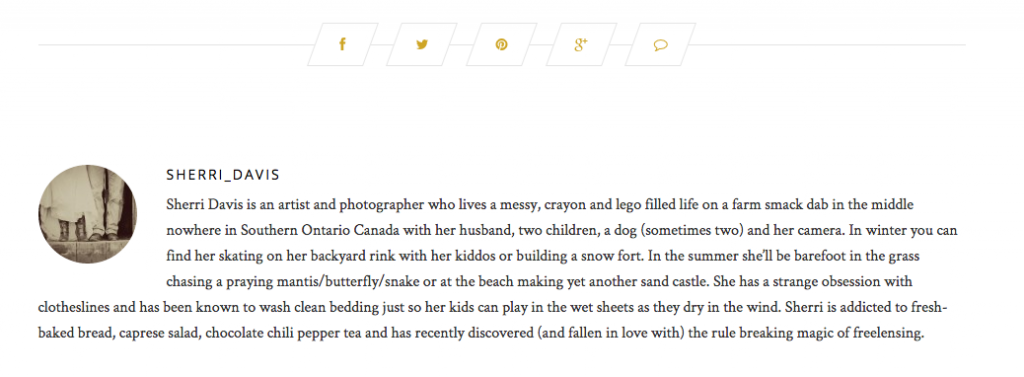Do you find it hard to describe yourself in just a few words? I know the feeling.
In fact, I find it extremely difficult to write short descriptions about myself. I know my name, I know what I do and what I’m good at but somehow, all I see is a blank space whenever I need to write my author bio.
It’s frustrating, especially when you don’t want to waste a lot of time, but you still want to write a quality bio. One that stands out, paints you in the best light and positively influences how readers perceive you (which is what branding is all about).
Luckily, I discovered some tips that work and I want to share them with you as well.
About pages offer you the luxury of space. You can include everything but the kitchen sink on the page.
Your name, a classy photo, your values, your professional journey, what your mission is. Maybe even a message for the fans.
You have a place to stretch out your thoughts. An author bio doesn’t work the same way.

You have limited space with which you can work. That is why you need a way to optimize your bio.
Otherwise, you won’t get the desired effects:
- Showing people how confident you are about your writing;
- Getting more people to read your content;
- More collaboration opportunities;
- An increased level of engagement for your posts;
If you don’t have a proper description after your articles, you stand to lose quite a lot.
So, how do you write a “million-dollar,” eye-catching piece of info about yourself? You’ll get the answer in the following lines, so let’s dive right in.
Use the Third Person in Your Description
About pages are always written in the first person. After all, you’re talking about your own achievements. An author bio is a different case.
Of course, you can use the first person if you have a personal blog and you are the sole writer.
However, there are some instances when writing your bio in the third person is your safest bet.
- For the times you’re going to guest post. You don’t have any control over the design of the author box on the host site. But you can still provide the text for them.
- It’s important not to use the first person for sites with multiple authors. Again, this is unless you’re the sole author of your blog.

The image above illustrates a good example of an author bio that makes use of the third person. It also makes sense when you think about it from a storytelling perspective.
People love stories; stories are (usually) written in the third person. See where I’m going with this?
Sherri told her own little story for her photography blog. It works very well for the overall mood she’s trying to convey in her bio.
The feeling of home sweet home.
Don’t Make It (All) about Yourself
Since we mentioned the About page, you should know one thing. You can’t make the author bio all about yourself.
You might be thinking: “What are you talking about? It’s MY bio!” Yes, it is. But you’re missing the irony here. People are always going to think about themselves first.
That is why your author bio should be about the readers, and what kind of value you can offer them. Establish yourself as an author who helps others with your work.

As you can see, Crystal here helps aspiring home improvement specialists gain attention for their work.
If people see it’s all about them, you increase the chances of a click-through to your writing. Ultimately, people want others to do stuff for them.
If you can’t offer them any help, a service, or anything useful, why should they give you the time of day?
Make it obvious to the reader how or why you will help them.
What Should You Include in Your Bio?
Make sure to include what it is you do best. If you’re a cook who happens to blog, explain that you’re good with recipes. That establishes your industry credibility.
Depending on what kind of site you run, you might not want to get too personal in your description.
People want to find out more about the people behind the content they’re reading… but not too much. Take what’s appropriate for your blog style into account, or keep it professional if you’d like to play it safe.
Like Elizabeth here:

Don’t forget to add a catchy call-to-action to your description. People won’t just click on your name unless you ask them to.
Think of what you want your readers to do when they see your author bio:
- Do you have a book out? Include a link where people can buy it from.
- Want them to read the rest of your blog? Include a link to it.
- Want people to contact you on social media? Add your info in the author box.
There’s no shortage of possibilities. Adapt your bio according to your personal or business needs.
Where Do You Place Your Author Bio?
Personally, we’ve noticed that setting your bio at the end of the article gets the most attention.
If you think about it, any reader parsing your page is most likely not going to start reading your author info first. They’ll dive straight into the article.
Some sites have bios so stealthy you don’t even notice them at first. People think it’s a part of the article and continue reading.
It feels a bit like cheating, doesn’t it? But hey, getting people to read it in the first place is a victory in itself. It’s one of the first steps towards them clicking on your other work.
I’m Still Not 100% Sure about What to Write…
Take notes from the bios we provided above. Maybe the muses will inspire you to write your own great author bio!
All of these tips are included in our eBook that will help you create the perfect online “You”. Click here to download it for free!
We realized people could use some more information on how to improve the quality of their online persona. You’ll find lots of useful information on how to enhance your personal brand.

You’ll also learn a few things about using Google to your advantage and how to increase quality traffic to your blog.
Moreover, you’ll find out about how to optimize your social media channels to garner all the attention.
Back to author bios now! We already went over how, why, where, and what you should write. The last step would be to get a nice canvas on which you can display your info.
A Shiny Box to Hold Your Bio
Any good author description needs a beautiful author box to hold it. Why waste so much time optimizing your bio if nobody bothers to look at it?
I mean, would you? Think about all the bios you’ve probably seen until now. Has any of them gained your attention in a pleasant way?
If yes, they probably had a really good WordPress plugin for it. Or they’re excellent programmers.
Since you learned so much about writing a bio, we figured it wouldn’t hurt to recommend a great author box plugin for it.
Check out Starbox at this link, and enjoy all the extra attention to your profile!














